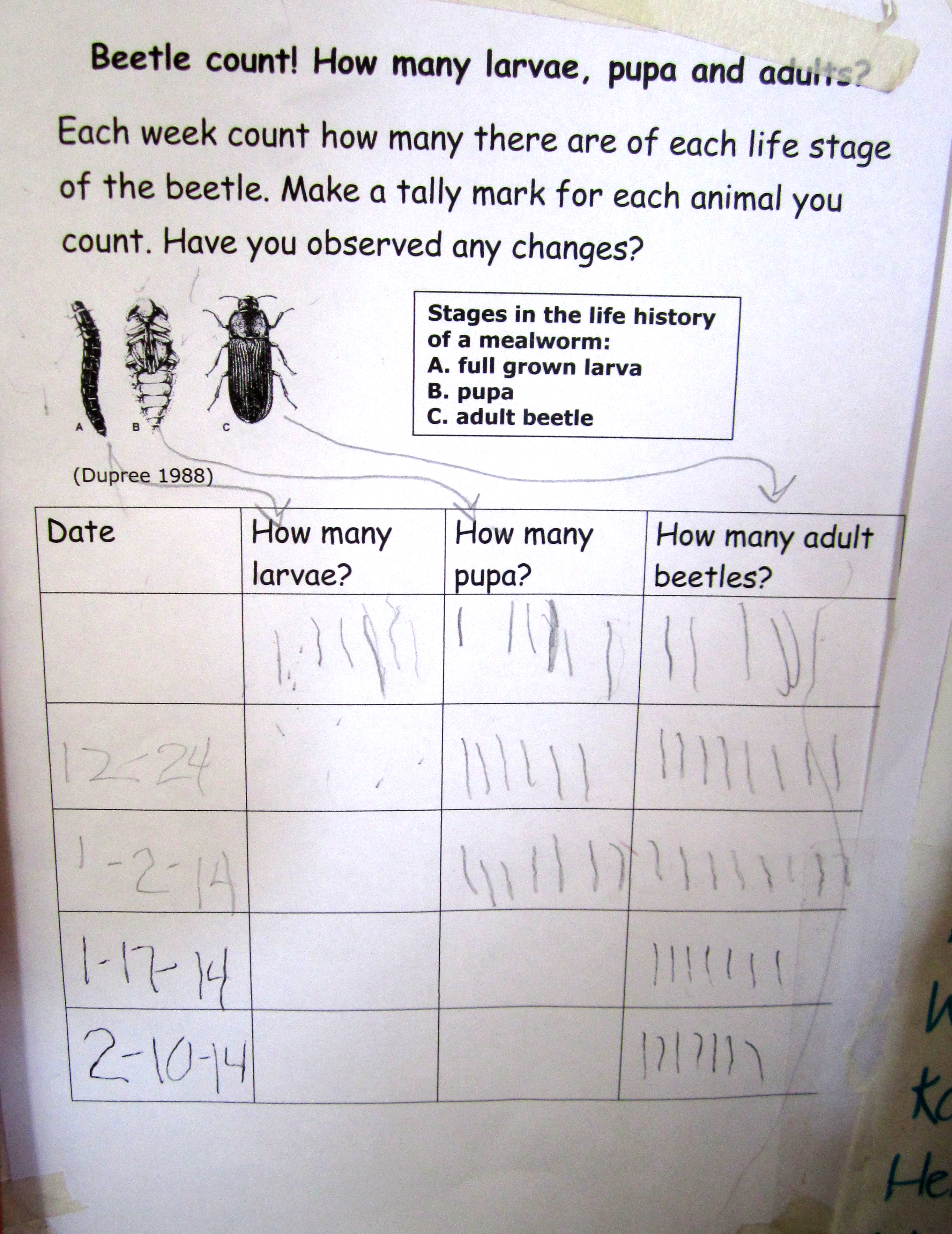Beetles before butterflies
By Peggy Ashbrook
Posted on 2016-02-25
 To prepare children to be close observers of the small animals that will be more easily seen in spring, I bring a container-habitat of beetles into the classroom during winter months. These Tenebrio beetles and larvae (widely known as “mealworms” although they are not worms) will live in the container, not colonize your classroom. Beetles in the classroom in a closed container, or on a tray, allows children to make hands-on observations of an insect as it changes from the baby form, a larva (like a caterpillar) to a pupa (like a chrysalis) to an adult beetle (like a butterfly). Observing more than one kind of small animal over time—isopods (roly-polies), gastropods (snails), insects, and others—introduces the diversity of animal life and provides multiple opportunities for children to build their understanding of living organisms.
To prepare children to be close observers of the small animals that will be more easily seen in spring, I bring a container-habitat of beetles into the classroom during winter months. These Tenebrio beetles and larvae (widely known as “mealworms” although they are not worms) will live in the container, not colonize your classroom. Beetles in the classroom in a closed container, or on a tray, allows children to make hands-on observations of an insect as it changes from the baby form, a larva (like a caterpillar) to a pupa (like a chrysalis) to an adult beetle (like a butterfly). Observing more than one kind of small animal over time—isopods (roly-polies), gastropods (snails), insects, and others—introduces the diversity of animal life and provides multiple opportunities for children to build their understanding of living organisms.
 Observing and caring for beetles also prepares children to observe and care for caterpillars in spring. Because children do not watch the larvae (baby beetles or caterpillars) continuously, they may not understand that a pupa or chrysalis is not a new animal but just a
Observing and caring for beetles also prepares children to observe and care for caterpillars in spring. Because children do not watch the larvae (baby beetles or caterpillars) continuously, they may not understand that a pupa or chrysalis is not a new animal but just a  new form of the baby insect that they have already seen. One way to support children’s developing understanding is to have them count the number of larvae in the Tenebrio beetle container-habitat every few days. How many babies can we find in the container? If you start with just 10 beetle larvae, children will be able to find all ten without losing interest. They can record their count (data) on a chart. Through regular observations and counts, children will notice when they find a pupa instead of all larvae. Their wonderings about this new form is an opportunity to wonder along with them and encourage them to draw to record their discovery.
new form of the baby insect that they have already seen. One way to support children’s developing understanding is to have them count the number of larvae in the Tenebrio beetle container-habitat every few days. How many babies can we find in the container? If you start with just 10 beetle larvae, children will be able to find all ten without losing interest. They can record their count (data) on a chart. Through regular observations and counts, children will notice when they find a pupa instead of all larvae. Their wonderings about this new form is an opportunity to wonder along with them and encourage them to draw to record their discovery.
Ms. Althea Pope, preschool teacher, made a poster size chart and added images of the children as they counted, further documentation that supports children’s view of themselves as practicing science. As children draw their observations of the insects over time they notice more and more details and become more comfortable with handling them.
I introduce “the babies” with a cooing voice, asking, “Does anyone want to see a baby beetle?” to help children feel comfortable. They know they are older than babies, and that we must be gentle with babies, so they respond with caretaking behavior rather than our other instinct of stepping on any small animal that moves. Some children will want to look closely but not hold the insects. Use small containers such as plastic baby food boxes so the beetles can be viewed closely. This also helps children with fine motor control difficulty hold them without accidently squishing them. Of course we never insist that a child get close to something that frightens them. We can offer them photographs or books to see what is so interesting to other children. A lamp can provide a bright light source in the classroom to help children with low vision see details.
While beetles may not have the poetic beauty of butterflies, they are more durable and children can easily handle them. They are sold as food for lizards and other pets at pet stores, in a refrigerated section.
Disclaimer: The views expressed in this blog post are those of the author(s) and do not necessarily reflect the official position of the National Science Teaching Association (NSTA).




